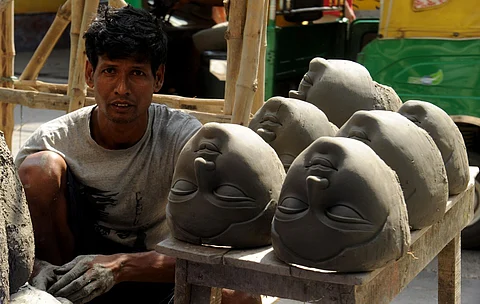
- Destinations
- Experiences
- Stay
- What's new
- Celebrating People
- Responsible Tourism
- CampaignsCampaigns
- Subscribe
- Buy Now

In the heart of the older part of Kolkata (also known as North Kolkata) lies Kumortuli, a traditional potters' colony that dates back to the 1700s. This area by the river Hooghly derives its name from the Bangla words 'kumor' (potter) and 'tuli' (locality). This is where the Durga idols for Bengal's biggest festival, Durga Puja, get made.
The kumor families trace their roots to Krishnanagar in Nadia district of West Bengal, known for its clay modelling craft. The kumors came here in the British era to create idols of the goddess for Durga Puja and eventually settled here. Many potter families in the area have been making idols for generations. The profession is still predominantly male, but a handful of women are trying to break this monopoly.
Right now, the area is buzzing with thousands of Durga idols taking shape under skilled hands. Take a walk around the narrow alleys lined with cheek-by-jowl potter studios, people working with wet mud and river clay, and a whole army of idols drying in the sun.
The first step in making a Durga idol is the foundation or skeleton structure, which is the 'kathamo'. This bamboo and wooden structure acts as a base to support the idol. The straw is methodically bound together over it, and the shape of the idol is formed. After that, the idol takes shape with river clay which is applied on the foundation structure. To remove impurities, the potters first stomp on the mud with their feet. The idol is then put out in the sun to dry for a few days to dry before paint is applied.
Traditionally the kumors (potters) have used earth-friendly material to make the idols. They would combine a special clay known as khori mati with colours. And use glue made from tamarind seeds. The powder of tamarind seeds would be used to help retain the colour of the clay idols.
The potters make many different styles of Durga idols, including the two main ones called "ek chala" (traditional one where all the idols of Durga and her family are on one backdrop), and "do chala" (this has more than one background, each idol comes with a separate one).
Getting There
From Howrah Railway Station, you can hire a taxi or ride-sharing service like Uber or Ola for a 5-6 kilometre journey. Similar options are available from Sealdah Railway Station, 3-4 kilometres away. If you're arriving at Kolkata Airport, you can opt for a prepaid taxi for the 15-kilometer trip, taking approximately 30-40 minutes. Alternatively, take a taxi, auto-rickshaw, or the Kolkata Metro from Esplanade or Park Street Area to reach Kumortuli in about 15-20 minutes. If you're near Howrah Bridge, it's a short 15-20 minute walk, or you can use other transport options like taxis or auto-rickshaws.
